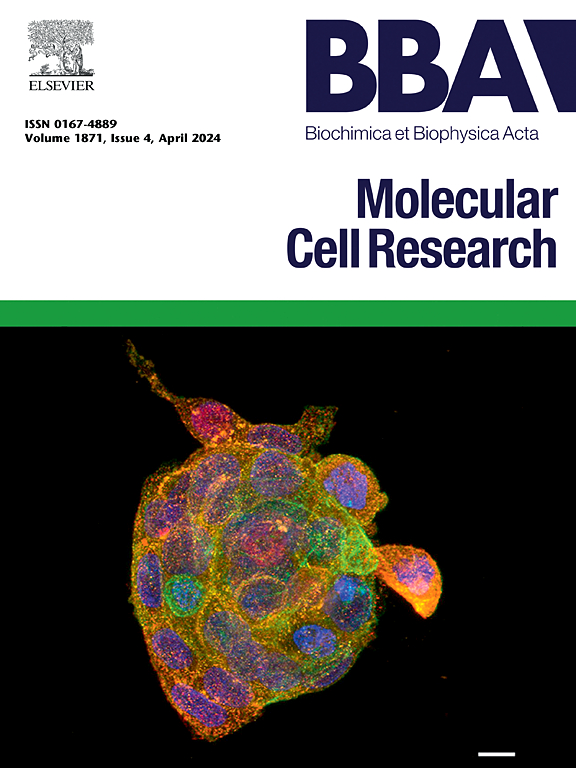Glaucoma-associated polymorphism M98K-OPTN sensitizes retinal cells to protein homeostasis stress through p62-mediated caspase activation
IF 3.7
2区 生物学
Q1 BIOCHEMISTRY & MOLECULAR BIOLOGY
Biochimica et biophysica acta. Molecular cell research
Pub Date : 2025-09-24
DOI:10.1016/j.bbamcr.2025.120064
引用次数: 0
Abstract
M98K polymorphism of OPTN is significantly associated with glaucoma in certain populations. This raises the possibility that M98K-OPTN alone is not sufficient to cause glaucoma, and it may require cooperation with other genetic or environmental factors to induce glaucoma. Loss of vision in glaucoma occurs due to the degeneration of retinal ganglion cells. Here, we have tested the hypothesis that M98K-OPTN may enhance the sensitivity of retinal cells to protein homeostasis stress. For this purpose, we have used M98K-OPTN expressing and wild-type (WT)-OPTN expressing clones of retinal 661W cells. Upon induction of protein homeostasis stress by a proteasome inhibitor MG132 (1–2 μM), M98K-OPTN expressing cells showed reduced survival, and enhanced caspase-8, caspase-9, and caspase-3 activation in comparison with WT-OPTN expressing cells. Compared to WT-OPTN expressing cells, M98K-OPTN expressing cells showed enhanced formation of p62/SQSTM1-positive aggregates and enhanced p62 protein level under conditions of protein homeostasis stress. Knockdown of p62 resulted in reduced caspase-9, caspase-8, and caspase-3 activation in M98K-OPTN expressing cells treated with proteasome inhibitor. Our results suggest that M98K-OPTN modulates protein homeostasis stress-induced signalling that mediates p62-dependent caspase activation, which leads to enhanced sensitivity of M98K-OPTN expressing retinal cells to protein homeostasis stress.

青光眼相关多态性M98K-OPTN通过p62介导的caspase激活使视网膜细胞对蛋白稳态应激敏感
在某些人群中,OPTN的M98K多态性与青光眼显著相关。这就提出了单独M98K-OPTN不足以引起青光眼的可能性,可能需要与其他遗传或环境因素共同作用才能诱发青光眼。青光眼的视力丧失是由于视网膜神经节细胞的退化。在这里,我们测试了M98K-OPTN可能增强视网膜细胞对蛋白质稳态应激的敏感性的假设。为此,我们使用了表达M98K-OPTN和野生型(WT)-OPTN的视网膜661W细胞克隆。蛋白酶体抑制剂MG132 (1-2 μM)诱导蛋白稳态应激后,与WT-OPTN表达细胞相比,表达M98K-OPTN的细胞存活率降低,caspase-8、caspase-9和caspase-3活性增强。与WT-OPTN表达细胞相比,M98K-OPTN表达细胞在蛋白稳态胁迫条件下p62/ sqstm1阳性聚集体的形成增强,p62蛋白水平升高。p62的敲低导致M98K-OPTN表达细胞中caspase-9、caspase-8和caspase-3活性降低。我们的研究结果表明,M98K-OPTN调节蛋白稳态应激诱导的信号,介导p62依赖性caspase激活,从而导致表达M98K-OPTN的视网膜细胞对蛋白稳态应激的敏感性增强。
本文章由计算机程序翻译,如有差异,请以英文原文为准。
求助全文
约1分钟内获得全文
求助全文
来源期刊
CiteScore
10.00
自引率
2.00%
发文量
151
审稿时长
44 days
期刊介绍:
BBA Molecular Cell Research focuses on understanding the mechanisms of cellular processes at the molecular level. These include aspects of cellular signaling, signal transduction, cell cycle, apoptosis, intracellular trafficking, secretory and endocytic pathways, biogenesis of cell organelles, cytoskeletal structures, cellular interactions, cell/tissue differentiation and cellular enzymology. Also included are studies at the interface between Cell Biology and Biophysics which apply for example novel imaging methods for characterizing cellular processes.

 求助内容:
求助内容: 应助结果提醒方式:
应助结果提醒方式:


